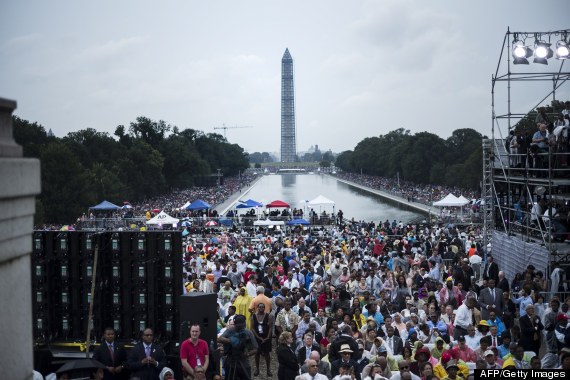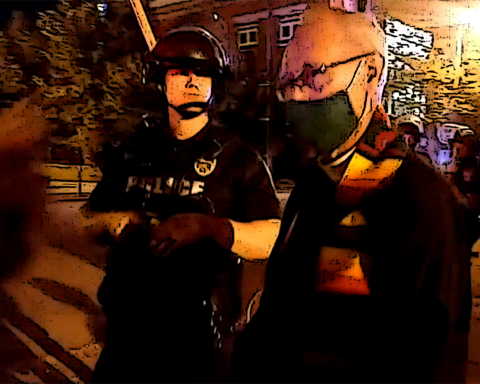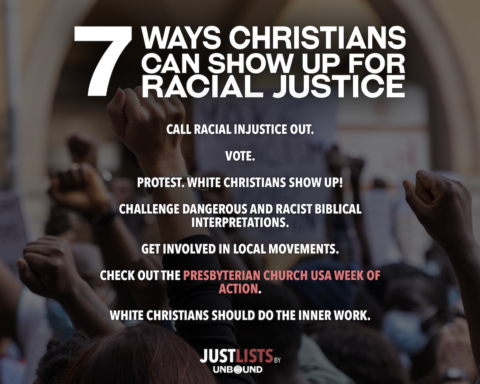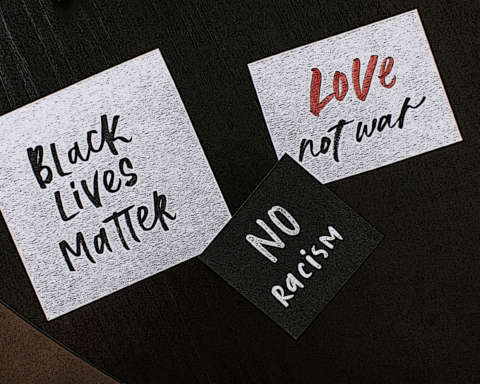Reviewed resource available in print or to download at newjimcroworganizing.org

Hunter builds on the work of Michelle Alexander’s book, The New Jim Crow: Mass Incarceration in the Age of Colorblindness. Alexander’s thesis is that the ‘War on Drugs’ was designed as and has become a ‘War on People of Color’, causing a dramatic increase in the number of persons incarcerated in the United States, disproportionately people of color. Hunter develops an organizing guide for communities who want to effect changes within society, changes of mindset and practice. Alexander herself has endorsed this concise 71-page guide.
The sprawling industry of incarceration, including the genesis of for-profit prisons, is indicative of the oppression our society has produced, particularly on people of color and people living in poverty. Public opinion has characterized the issues of addiction and selling drugs as primarily based on race. Yet, statistics indicate that the use and sale of illegal drugs are similar in all races, with no exceptions.
Our national drug policies are based on policing and arresting people for possession and/or the intent to sell. It focuses on the supply, not the demand that United States citizens create. The mandatory sentences imposed by drug policies do much to destroy our families and communities and take away from judges the power to use positive alternatives to assist individuals in handling their drug usage while remaining within their families and working in the community.
___________________________________________
Alexander’s thesis is that the ‘War on Drugs’ was designed as and has become a ‘War on People of Color’.
___________________________________________
In the face of this reality, Hunter constructs a case showing that too often activism is unproductive in changing the direction of our social systems. Frequently, efforts begin and end with disseminating information and statistics, but fail in engaging people to take positive actions toward the dismantling of the injustice perpetuated in our social structures. This booklet, then, in Hunter’s words, “seeks to focus people in the direction of dismantling our nation’s huge and egregious prison industrial system.”

Hunter presents an image that clearly illustrates how all of us are affected by our culture’s treatment of drug usage. Even though people generally attempt to be healthy in their lifestyles and habits, we cannot avoid inhaling the smog and pollution in the air; it just becomes a part of our body’s chemistry. In the same way, everyone in our nation have been affected by the fear tactics of the drug war: characterizations of people, media images, racist biases, policing practices and federal grants based on arrests, and the permeated belief that we can solve the drug crisis by locking up and putting out of sight those who are using or selling drugs. The media are quick to announce drug busts and arrests, and society becomes more complacent thinking that we are ‘winning the war’. Yet none this addresses the huge demand for drugs that we and our neighbors are creating.
Hunter challenges his readers to become seriously engaged in transforming our mental processes and our systems of health and justice. Thus, he thoughtfully outlines the process by which engagement can happen. In three brief chapters, with many specific illustrations, he walks the reader through the various dynamics of community organization.
Roles in Movement Building
 He begins by addressing some of the myths around movements that need to be unlearned:
He begins by addressing some of the myths around movements that need to be unlearned:
- Movements are lit like a match.
- Movements are built by heroic figurehead leaders.
- Movements require complete internal unity.
- Movements succeed only if they mobilize large, mass actions.
Within any successful movement there are different roles people take: helpers, advocates, organizers, and rebels. Each person needs to self-identify which role is compatible with his/her personality and assets. Accepting your function within a movement allows you to respect the work of others without burdening yourself with every task. “Each role is vital in movement-building: Helpers’ direct services, Advocates’ accessing resources inside the system, Organizers’ pulling people together to struggle for their own solutions, and Rebels’ in-your-face actions that speak truth to power.”
Hunter carefully lists the assets and liabilities for each role, and includes warnings in each category that would isolate people and/or unintentionally perpetuate the systemic injustice.
Building Strong Groups
Hunter emphasizes that relationships between individuals are the building blocks for successful movements. It is essential that relationships be established with the communities who experience the injustice of our social structure, i.e., incarcerated people, recently released persons, persons struggling with addictions, and individuals being denied access to health resources and treatment. It is necessary to encourage and empower people who have been denied justice to speak and to be companions with them; this may require taking risks for the sake of stimulating significant change. Hunter writes, “Movements are built on webs of relationships.”

Movements grow as individuals speak to others, one-on-one straightforwardly. General announcements do not usually stir people’s emotions and passions. These one-on-one encounters have three basic components:
- Finding a time to talk with someone;
- Listening to that person to understand where they’re coming from; and,
- Making a specific ask tailored to who and where they are (for example sign a petition, bring juice to the next meeting, or speak at an upcoming event)
Hunter then cites Gail Tyree as an excellent model for using one-on-one encounters to enhance and enrich a movement. Getting people motivated is crucial. Gail advises, “When you’re working as an organizer, you’re almost like a neighborhood psychologist. You have to help people through their pain. You should spend most of the time listening to the pain.” (Gail is also a member of the Presbyterian drug policy task force.)
___________________________________________
Gail advises, “When you’re working as an organizer, you’re almost like a neighborhood psychologist. You have to help people through their pain. You should spend most of the time listening to the pain.”
___________________________________________
Hunter points out that people live in social circles/clusters. For a movement to gain momentum, it must connect with other groups that have similar goals and interests, though they may be working in a different realm. Groups can be supportive of other groups to publicly increase the magnitude of community presence that is attempting to instigate changes for a more just social order.
 He then addresses the perception of power that permeates most of our mental images: that power comes down from the top. He challenges this perception by reminding readers that there are pillars of power within communities that hold up the social structure. Movements can address how these pillars can be removed by using our own personal power, telling stories of justice being denied, of harm being perpetrated, of the social epidemic of the fear of ‘the other’ paralyzing society and permitting its cancerous growth to destroy human community from within.
He then addresses the perception of power that permeates most of our mental images: that power comes down from the top. He challenges this perception by reminding readers that there are pillars of power within communities that hold up the social structure. Movements can address how these pillars can be removed by using our own personal power, telling stories of justice being denied, of harm being perpetrated, of the social epidemic of the fear of ‘the other’ paralyzing society and permitting its cancerous growth to destroy human community from within.
Movements are challenged to empower the oppressed and support their leadership. For instance, enabling formerly incarcerated individuals to voice the failure of our correctional systems to provide healthcare, skills training and educational opportunities, re-entry processes, and respectful treatment by staff. “Creativity, risk-taking, and ingenuity need to be unshackled from worries about national reputation, concerned donors, or ensconced stakeholders.” Grassroots change requires movements to address and impact local realities of injustice. Local movements then can add their voices to national movements as they deem appropriate.
Creating Effective Campaigns
Hunter then addresses how strong groups address a specific campaign strategy. He writes: “Campaigns channel group power by focusing on a concrete goal…Campaigns identify a piece of what we want and work toward achieving it…Campaigns inspire people into further action and help them understand the depth of the problem.” Movements begin with initial steps which, when accomplished, lead to the next action and onward towards the ultimate campaign goal. A strategic plan outlines the different targets, tactics, educational events, and pressure points; develops grassroots leadership; connects with new allies; and takes the initiative to build its own timeline for change.
 It is important to be as specific and realistic as possible in defining the campaign goal. Because the system is so broad and covers many different angles, a successful movement identifies a specific target and develops its strategy toward that goal. It remains aware of the work of other movements addressing the larger concern, though doesn’t attempt to cover the whole area. As a movement begins to discern what its focus will be, the voices of the people who have been subject to the oppressions being addressed need to be heard, respected, and incorporated into the campaign goal. Hunter offers several processes for defining the target of a community movement.
It is important to be as specific and realistic as possible in defining the campaign goal. Because the system is so broad and covers many different angles, a successful movement identifies a specific target and develops its strategy toward that goal. It remains aware of the work of other movements addressing the larger concern, though doesn’t attempt to cover the whole area. As a movement begins to discern what its focus will be, the voices of the people who have been subject to the oppressions being addressed need to be heard, respected, and incorporated into the campaign goal. Hunter offers several processes for defining the target of a community movement.
The strategies need to be implemented in such a way to build upon the power of the individual and, thus, increase self-esteem and self-image in positive ways. Creative actions dramatize the need and bring the attention of society into a common focus on the injustice that is being addressed. This demands boldness, courage, and risk-taking as movements speak truth to power. Hunter cites the great abolitionist Frederick Douglas:
Power concedes nothing without a demand. It never did and it never will. Find out just what any people will quietly submit to and you have found out the exact measure of injustice and wrong which will be imposed upon them, and these will continue till they are resisted.
Hunter describes the spectrum of people’s relationship to a movement: active allies, passive allies, neutral, passive opposition, active opposition. The task for movement members is to attempt to move people into the category closer to ‘active allies’ from where they are situated at the moment. For example, move the neutral folks into becoming passive allies. This work entails much personal contact and connection, and it is imperative for a campaign goal to be reached.

Photo Credit BRENDAN SMIALOWSKI/AFP/Getty Images)
Effective campaigns offer alternatives that reflect the highest values of humanity. They can do this constructively and creatively in what Hunter describes as dilemma demonstrations, defined as “actions that force the target to either let you do what you want, or be shown as unreasonable as they stop you from doing it.” These demonstrations call public attention to the injustice being meted out in some of our systems. As the saying goes, actions speak louder than words, or as St. Francis of Assisi is reported to have stated: “Preach the Gospel at all times…if necessary use words.” Hunter cites several examples of effective dilemma demonstrations.
In conclusion, Hunter indicates that a successful movement is measured by the number of hearts and minds that have been convinced and moved to a new way of thinking and being in the community of humanity. The human community is inclusive of every individual; under no circumstances can we categorize individuals as ‘the other’. Hunter closes his booklet with these challenging words from Dr. Martin Luther King Jr.:
We must come to see that human progress never rolls in on the wheels of inevitability. It comes through the tireless efforts and the persistent work of dedicated individuals.
*****
AUTHOR BIO: Rev. B. Gordon Edwards (Broken Arrow, OK, Chairperson) is Executive Presbyter of Cimarron Presbytery, and served as pastor of the First Presbyterian Church in Stillwater, OK. He also serves as a member of the Payne County (OK) Drug Court Board. He previously was chair of the Presbyterian Church (U.S.A)’s Advisory Committee on Social Witness Policy, and attended McCormick Theological Seminary.





Unbound Social